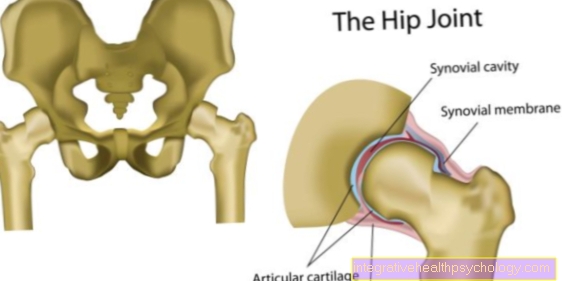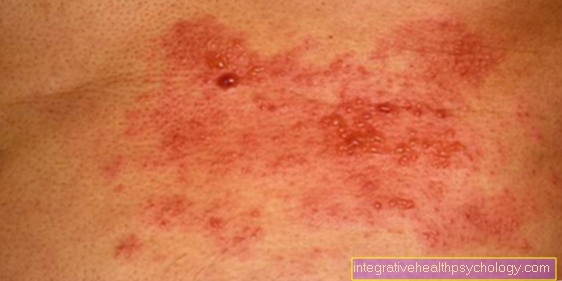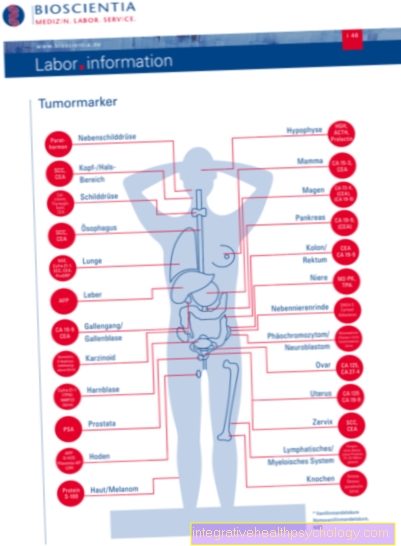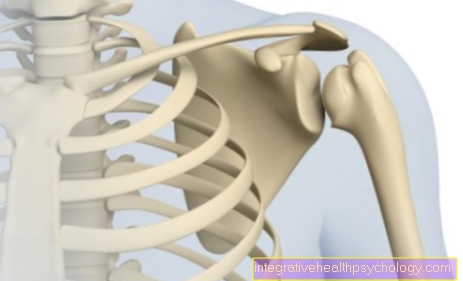Post Traumatic Stress Disorder (PTSD)
Synonyms
Post Traumatic stress Disorder, PTSD, trauma
definition
The actual name of the post traumatic stress disorder finds its origin in the military (see also Mental disorder). Soldiers who were unfit for service during the Vietnam War due to various war events because they were exposed to the greatest physical or emotional stress were given this diagnosis. In previous wars, the disorder was given different names. In World War I e.g. one used the very apt name "Shell Shock". This called quasi the shock (shock) of the innermost psychic core (shell).
Nowadays diagnosis is also used in civilian areas. Whenever a person is exposed to an event of exceptional physical or mental threat, there is a risk of developing PTSD.
Epidemiology
.jpg)
Women are usually affected much more often than men. Some studies assume a ratio of 2: 1. Possible reasons for this are e.g. the high probability of developing PTSD (post-traumatic stress disorder) after rape (probability approx. 50%), as well as the probability of approx. 20% in victims of violent acts.
The risk for women of becoming a victim of rape once in their life is around 8% in Germany.
Overall, the probability of developing PTSD (post-traumatic stress disorder) once in a lifetime is between 10-12% for women and between 5-6% for men.
Other traumas with a high PTSD risk are: combat deployment in war, child abuse, torture, imprisonment, but also car accidents or being an eyewitness to an accident.
Diagnosis
Diagnostic criteria according to ICD-10 / symptoms / symptoms
Symptoms typically appear within 6 months of the stressful event. A later start may also be possible.
- Those affected were exposed to an event or occurrence of extraordinary threat or catastrophic proportions that would cause profound despair in almost anyone.
- Persistent memories or reliving stress from intrusive reverberation memories (flashbacks), vivid memories, repetitive dreams, or distress in situations similar or related to the stress. (There may also be a kind of emotional dullness or indifference and indifference)
- Similar circumstances are actually avoided or as far as possible. This behavior did not exist before the event
- One of the points below:
- Inability to remember some important aspects of the trauma
- Persistent symptoms of increased psychological sensitivity and arousal (not before dreaming) with two of the following:
- Difficulty falling asleep and staying asleep (sleep disorder)
- Irritability or outbursts of anger
- Difficulty concentrating
- Hypervigilance (state of agitation)
- Increased jumpiness
The diagnosis should be carried out by a doctor or psychologist experienced in psychotherapy. 2 instruments typically used in diagnostics are:
"Impact of Event Scale" - R (IES-R) Horowitz et al. 79, German version: Maercker 98
4 factor structure:
- "Intrusion" (reverberation memories)
- "Avoidance"
- "Overexcitation"
- "Numbing" (emotional numbness)
The questionnaire is short and simple.
Questionnaire on thoughts after traumatic experiences (PTCI) Foa, Ehlers 2000
Self-disclosure instrument for identifying problematic interpretations of the trauma and its consequences, seven-point Likert scale, 3 factors.
- Negative cognitions about yourself
- Negative cognitions about the world
- Self-blame
Causes of the development of post-traumatic stress disorder:
Fault concept according to Ehlers and Clark:
fear is a feeling that usually relates to a current or future situation. In PTSD (post-traumatic stress disorder), however, a massive feeling of fear with the above Symptoms due to a past event. In the disorder model according to Ehlers and Clark, it is now assumed that the affected person processed the trauma incorrectly in such a way that memories of the event are perceived as a current, present threat. In terms of perception, it is generally assumed that two processes can be held responsible for the fact that a person perceives past events as currently threatening.
- The individual interpretation (interpretation) of the event and its consequences: It is believed that patients with PTSD cannot see the bad event as a temporary event that will not necessarily have a negative impact on their lives.It is also assumed that patients with PTSD (post-traumatic stress disorder) evaluate and interpret the event and its consequences so often negatively that it leads to the perception of a very current threat.
- The so-called “trauma memory”: Patients with PTSD often have great difficulty in fully deliberately remembering the event. Often there are only fragmentary memories. On the other hand, there are unwanted memories that force themselves on the patient. In these moments, he experiences them as if the event would happen again in the present moment. The trauma cannot be inserted into the actual structures of memory. Usually we put memories in a temporal context (E.g. That was 1999. It was difficult, but it's over ... ”). This just doesn't work with PTSD. The feeling of threat can arise at any time due to relatively minor stimuli (e.g. slamming a car door is a reminder of a car accident, etc.).
_2.jpg)
These stimuli remind the patient of stimuli that they perceived shortly before or during the trauma (sounds, smells, etc.). Stimulus and trauma are thus coupled, so to speak. Whenever the patient then perceives such or similar stimuli later, this coupling can make the trauma present again in one fell swoop without the patient being able to explain it.
In addition, patients with PTSD seem to be more attentive to bad, trauma-specific stimuli (so-called priming). (E.g. a woman who was attacked by a bearded man sees men with her beard often immediately out of a crowd.)
As a result, such disturbances in perception usually result in a change in behavior and thoughts. Patients very often tend to avoid situations which they believe may be disturbing. Also, any thoughts about the event are often suppressed. Unfortunately, this avoidant behavior usually has the opposite (paradoxical) effect, i.e. there is an increased occurrence of thoughts and feelings of threat.
Differential diagnosis
The differential diagnoses (alternative causes of illness) are of particular importance. In recent years there has been a kind of “PTSD sell-out”, especially among “non-therapists”. Post-traumatic stress disorder has become a kind of “fashion diagnosis”. This is problematic in that, if the diagnosis is wrong, wrong therapeutic approaches are followed, which on the one hand usually does not really help the patient and on the other hand causes immense costs that could be saved with more precise knowledge of the differential diagnoses. A distinction must be made between the following in terms of differential diagnosis:
- Acute stress reaction: If the symptoms (see point ICD-10 / Symptoms) last only a few hours or days (at most 4 weeks) and then disappear again due to an event, we speak of an acute stress reaction.
- Adjustment disorder: The adjustment disorder typically does not meet all of the symptoms of PTSD (post-traumatic stress disorder). This disorder often arises after events that are less “catastrophic” (mostly after separations, bereavement or serious physical illness). (However, even the worst disasters can lead to adjustment disorder.)
- Grief Reaction: Grief reactions are completely normal. However, if it does not subside for a certain period of time (6 months), it is known as an "abnormal grief response". This falls under the adjustment disorders.
- Persistent change in personality: Persistent or repeated traumatic experiences (abuse, torture, imprisonment, etc.) can lead to permanent changes in the basic personality.




















.jpg)








